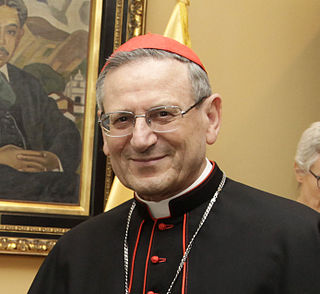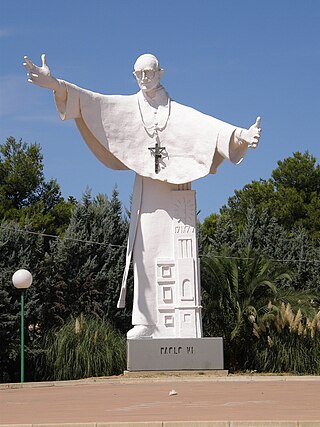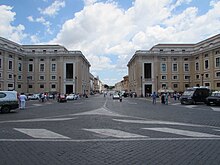
Canonization is the declaration of a deceased person as an officially recognized saint, specifically, the official act of a Christian communion declaring a person worthy of public veneration and entering their name in the canon catalogue of saints, or authorized list of that communion's recognized saints.
The Roman Curia comprises the administrative institutions of the Holy See and the central body through which the affairs of the Roman Catholic Church are conducted. The Roman Curia is the institution which the Roman Pontiff ordinarily makes use of in the exercise of his supreme pastoral office and universal mission in the world. It is at the service of the Pope, successor of Peter, and of the Bishops, successors of the Apostles, according to the modalities that are proper to the nature of each one, fulfilling their function with an evangelical spirit, working for the good and at the service of communion, unity and edification of the Universal Church and attending to the demands of the world in which the Church is called to fulfill its mission.

Beatification is a recognition accorded by the Catholic Church of a deceased person's entrance into Heaven and capacity to intercede on behalf of individuals who pray in their name. Beati is the plural form, referring to those who have undergone the process of beatification; they possess the title of "Blessed" before their names and are often referred to in English as "a Blessed" or, plurally, "Blesseds".
The process of beatification and canonization has undergone various reforms in the history of the Roman Catholic Church. For current practice, as well as a discussion of similar processes in other churches, see the article on canonization. This article describes the process as it was before the promulgation of the Codex Iuris Canonici of 1983.

The Forty Martyrs of England and Wales or Cuthbert Mayne and Thirty-Nine Companion Martyrs are a group of Catholic, lay and religious, men and women, executed between 1535 and 1679 for treason and related offences under various laws enacted by Parliament during the English Reformation. The individuals listed range from Carthusian monks who in 1535 declined to accept Henry VIII's Act of Supremacy, to seminary priests who were caught up in the alleged Popish Plot against Charles II in 1679. Many were sentenced to death at show trials, or with no trial at all.

José Saraiva Martins, C.M.F. GCC is a Portuguese cardinal of the Catholic Church. He was prefect of the Congregation for the Causes of Saints from 1998 to 2008.

The Dicastery for Bishops, formerly named Congregation for Bishops, is the department of the Roman Curia that oversees the selection of most new bishops. Its proposals require papal approval to take effect, but are usually followed. The Dicastery also schedules the visits at five-year intervals that bishops are required to make to Rome, when they meet with the pope and various departments of the Curia. It also manages the formation of new dioceses. It is one of the more influential Dicasteries, since it strongly influences the human resources policy of the church.
Canonization of Josemaría Escrivá de Balaguer discusses John Paul II's decision to canonize Josemaría Escrivá, founder of the Prelature of the Holy Cross and Opus Dei, more commonly known as Opus Dei.

Devasahayam Pillai or Mar Lazarus Sahada was an Indian layman and martyr of the Catholic Church. He was canonized as a saint of the church by Pope Francis on 15 May 2022.

Irmã Dulce, also known as Saint Dulce of the Poor was a Brazilian Catholic Franciscan Sister who was the founder of the Obras Sociais Irmã Dulce.
During the Spanish Civil War Catholic people faced persecution from the Republican faction of the war, in part due to their support of the nationalists and the recently abolished monarchy. The Catholic Church venerates them as martyrs. More than 6,800 clerics and other Catholic people were killed in what has been dubbed the Red Terror. As of November 2023, 2,127 Spanish martyrs have been beatified; 11 of them being canonized. For some 2,000 additional martyrs, the beatification process is underway

Angelo Amato, S.D.B. is an Italian cardinal of the Catholic Church who served as the Prefect of the Congregation for the Causes of Saints between 2008 and 2018. He served as Secretary of the Congregation for the Doctrine of the Faith from 2002 to 2008 and became a cardinal in 2010.

Pope John Paul II reigned as pope of the Roman Catholic Church and sovereign of the Vatican City State for 26 years from October 1978 to his death, on 2 April 2005. Since his death, many thousands of people have been supporting the case for beatifying and canonising Pope John Paul II as a saint. His formal beatification ceremony took place on 1 May 2011.

Marie-Alphonsine Danil Ghattas was a Palestinian Christian nun who founded the Dominican Sisters of the Most Holy Rosary of Jerusalem, the first Palestinian congregation. She was beatified by Archbishop Angelo Amato on behalf of Pope Benedict XVI in 2009.
Marcello Bartolucci is an Italian prelate of the Catholic Church. He has held the rank of archbishop since 2011 and was the Secretary of the Congregation for the Causes of Saints from 2010 to 2021. He held several other posts in that Congregation beginning in 1977.

Maria Domenica Mantovani was an Italian Roman Catholic professed religious, and the co-founder of the Little Sisters of the Holy Family; she established them alongside Giuseppe Nascimbeni. As a nun she received the religious name of Maria of the Immaculate.

The cause for the canonization of Pope Paul VI, who died in 1978, commenced in 1993 and he was canonized on 14 October 2018. After having been proclaimed a Servant of God and declared Venerable, he was beatified on 19 October 2014, after the recognition of a miracle had been attributed to his intercession, and declared a saint by Pope Francis on 14 October 2018.
Maiorem hac dilectionem is an apostolic letter issued in the form of a motu proprio of Pope Francis, dated 11 July 2017. The document creates a new path towards sainthood under the canonization procedures of the Roman Catholic Church, through the path of oblatio vitae. This means the offering of one's life and premature death for another individual; it is to give one's life as a sacrifice for another.

Sandra Maria Assunta Sabattini was an Italian diarist, medical student, and member of the Pope John XXIII Community, who was beatified by the Catholic Church on 24 October 2021.

















